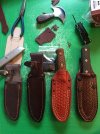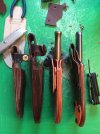- Joined
- Aug 29, 2010
- Messages
- 13,545
Thought I'd start a thread on this topic as it came up briefly the other day.
There's too many to list, but in this subforum specifically Horsewright, Duramax and G2 come immediately to mind but there are many more and I would leave way too many out to try to list them all.
I've always enjoyed when you see a piece of work and recognize who made it at a glance without a logo needed.
Personally, as my leather skills slowly improve I still don't have a style but I am beginning to see consistency. Is that the first "phase" of a style appearing on it's own?
A lot of times it's a specific stitching, rivet, shape, texture, color, stamping, or all of them combined. There's work that people see and can't necesarily put their finger on it but they know who made it. The details come together and create their own presence even though individually those details may seem common. Other times it's a specific piece of the puzzle that screams a Makers name. The beauty of it is that both equally create that recognition and style. It can either be a side effect or intentional.
As a buyer does it matter? Does it matter if a Maker makes his own sheaths or farms it out? As a Maker do these things even cross your mind? Thought this might be an interesting conversation to have here. We can always move it elsewhere if need be.
John
There's too many to list, but in this subforum specifically Horsewright, Duramax and G2 come immediately to mind but there are many more and I would leave way too many out to try to list them all.
I've always enjoyed when you see a piece of work and recognize who made it at a glance without a logo needed.
Personally, as my leather skills slowly improve I still don't have a style but I am beginning to see consistency. Is that the first "phase" of a style appearing on it's own?
A lot of times it's a specific stitching, rivet, shape, texture, color, stamping, or all of them combined. There's work that people see and can't necesarily put their finger on it but they know who made it. The details come together and create their own presence even though individually those details may seem common. Other times it's a specific piece of the puzzle that screams a Makers name. The beauty of it is that both equally create that recognition and style. It can either be a side effect or intentional.
As a buyer does it matter? Does it matter if a Maker makes his own sheaths or farms it out? As a Maker do these things even cross your mind? Thought this might be an interesting conversation to have here. We can always move it elsewhere if need be.
John


